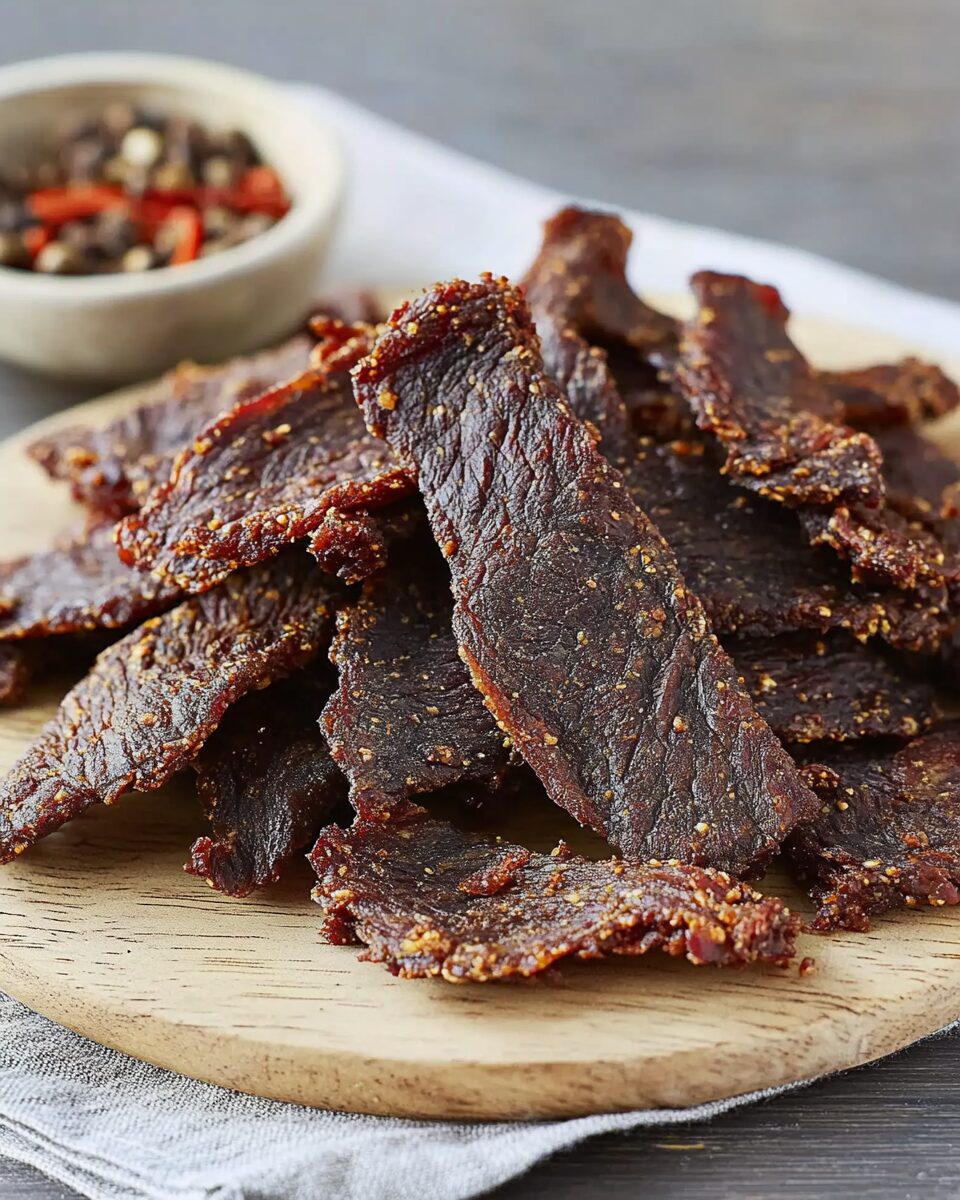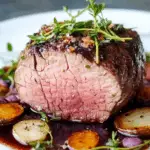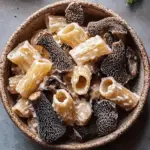Homemade beef jerky is a savory, protein-rich snack made by marinating lean cuts of beef and drying them to preserve flavor and extend shelf life. This traditional method of meat preservation has evolved into a popular treat enjoyed by many.
Full Recipe:
Ingredients
- 2 pounds beef top round, thinly sliced
- ⅔ cup soy sauce
- ¼ cup Worcestershire sauce
- 1 tablespoon brown sugar
- 2 teaspoons liquid smoke flavoring
- 2 teaspoons onion powder
- 2 teaspoons chili powder
- 2 teaspoons garlic powder
- 2 teaspoons cayenne pepper
- 2 teaspoons finely ground black pepper
Directions
-
Marinate the Beef:
- In a large bowl, combine soy sauce, Worcestershire sauce, brown sugar, liquid smoke, onion powder, chili powder, garlic powder, cayenne pepper, and black pepper.
- Add the beef slices to the marinade, ensuring they are thoroughly coated.
- Cover and refrigerate for 3 hours to overnight, allowing the flavors to meld.
-
Dry the Beef:
- Preheat your oven or dehydrator to 175°F (80°C).
- Arrange the marinated beef slices on wire racks, ensuring they do not overlap.
- Dry in the oven or dehydrator until the jerky is dry but still pliable, about 3 to 4 hours.
Nutritional Facts (per serving)
- Calories: 116
- Total Fat: 7.3g
- Saturated Fat: 3g
- Cholesterol: 20mg
- Sodium: 600mg
- Total Carbohydrates: 3g
- Dietary Fiber: 0g
- Total Sugars: 2g
- Protein: 10g
- Iron: 1mg
- Potassium: 150mg
The History of Beef Jerky
Beef jerky has been around for centuries and was originally a survival food for early civilizations. Indigenous peoples of North and South America, including the Quechua people of the Inca Empire, created a similar preserved meat called “charqui,” which is where the word “jerky” originates. They would cut meat into thin strips, salt it, and dry it in the sun or over a low fire to prevent spoilage.
As explorers and settlers moved across continents, they adopted the practice of drying meat to create a portable, non-perishable food source. Today, beef jerky remains a popular snack, but modern preparation methods include a wide variety of seasonings, marinades, and drying techniques.
Why Homemade Beef Jerky is Better than Store-Bought
- No Artificial Preservatives – Many store-bought jerkies contain artificial preservatives, excess sodium, and added sugars. When making jerky at home, you have complete control over the ingredients, ensuring a healthier final product.
- Customizable Flavors – Homemade beef jerky allows you to experiment with different marinades, spices, and levels of heat to create a snack that perfectly suits your taste.
- Better Meat Quality – By selecting your own cuts of beef, you can choose high-quality, lean meat without unnecessary fillers or additives.
- Cost-Effective – While premium beef jerky can be expensive at the store, making it at home is often more affordable, especially when buying meat in bulk.
- Healthier Snack Option – Since beef jerky is naturally high in protein and low in carbohydrates, it is an excellent snack for those following high-protein, keto, or paleo diets.
Choosing the Best Meat for Beef Jerky
The key to great beef jerky lies in selecting the right cut of meat. The best choices are lean cuts with minimal fat, as fat does not dry well and can lead to spoilage. Some of the best cuts for homemade beef jerky include:
- Top Round – One of the most popular choices due to its lean nature and affordability.
- Bottom Round – Slightly tougher than top round but still a great option for jerky.
- Sirloin Tip – Offers a good balance of leanness and tenderness.
- Eye of Round – A lean cut with minimal marbling, ideal for long-lasting jerky.
- Flank Steak – A more flavorful option, though slightly more expensive.
When preparing the meat, slicing it thinly (about 1/8 to 1/4 inch thick) helps ensure even drying and a better texture. Cutting against the grain results in a more tender jerky, while slicing with the grain gives a chewier texture.
Marination: The Secret to Flavorful Jerky
Marinating beef before drying is essential for infusing it with flavor and ensuring that it remains tender. The marinade typically includes a combination of salty, sweet, acidic, and spicy ingredients to create a well-balanced taste.
- Salt and Soy Sauce – Essential for flavor and preservation.
- Worcestershire Sauce – Adds depth and enhances umami flavor.
- Brown Sugar or Honey – Provides a touch of sweetness to balance out the saltiness.
- Garlic and Onion Powder – Boosts savory flavors.
- Black Pepper and Cayenne – Adds a slight heat that can be adjusted to preference.
- Liquid Smoke – Mimics the natural smokiness of traditional jerky cooked over an open fire.
Marinating for at least 3 hours (or preferably overnight) allows the flavors to fully penetrate the meat and ensures a more delicious final product.
The Drying Process: Oven vs. Dehydrator
Beef jerky is traditionally dried using either an oven or a dehydrator. Both methods are effective, but each has its own advantages.
- Oven Method – Using a low temperature (around 175°F or 80°C) in the oven allows for consistent drying. The key is to place the beef slices on wire racks to allow air circulation. Keeping the oven door slightly open helps with moisture evaporation.
- Dehydrator Method – A food dehydrator is a more energy-efficient and convenient way to dry beef jerky. It circulates air evenly at a low temperature, ensuring a steady drying process. This method is recommended for those who make jerky regularly.
The drying process typically takes about 3 to 4 hours, depending on the thickness of the slices and the drying method used. The jerky is ready when it is firm but pliable, with no moisture remaining.
Storing Homemade Beef Jerky
Proper storage is crucial for maintaining the freshness and longevity of homemade beef jerky.
- Short-Term Storage (1-2 Weeks) – Store jerky in an airtight container or resealable plastic bag at room temperature.
- Refrigeration (Up to 1 Month) – If you plan to keep jerky for longer, storing it in the refrigerator helps maintain freshness.
- Freezing (Up to 6 Months) – For long-term storage, freezing jerky in vacuum-sealed bags preserves its quality.
Since homemade jerky does not contain preservatives, it is best to consume it within a reasonable timeframe to enjoy its optimal flavor and texture.
Variations and Ways to Customize Your Jerky
One of the best parts of making beef jerky at home is the ability to experiment with different flavors and ingredients. Here are a few ideas for variations:
- Teriyaki Jerky – Add pineapple juice, soy sauce, and ginger for a sweet and tangy flavor.
- Spicy Sriracha Jerky – Mix sriracha sauce into the marinade for an extra kick.
- Peppered Jerky – Coat the beef with freshly cracked black pepper before drying.
- BBQ Jerky – Use a barbecue sauce-based marinade for a smoky-sweet finish.
Health Benefits of Beef Jerky
- High in Protein – A great source of lean protein, ideal for muscle recovery and sustained energy.
- Low in Carbs – Perfect for those following a low-carb or ketogenic diet.
- Long Shelf Life – Does not require refrigeration, making it an excellent travel snack.
- Rich in Iron and Zinc – Essential minerals that support immune function and overall health.
Conclusion
Homemade beef jerky is a fantastic snack that is not only delicious but also highly nutritious and easy to make. By preparing it at home, you can avoid unnecessary preservatives and additives while enjoying a customized flavor that suits your taste.
With the right meat selection, a flavorful marinade, and proper drying techniques, you can create jerky that rivals or even surpasses store-bought versions. Whether you prefer classic, spicy, or sweet flavors, the versatility of homemade jerky allows for endless possibilities.






